


Travel
NEPAL
It didn’t help to see the driver constantly crossing himself as we hurtled along the pot-holed road. It also appeared he was having a running battle with his charge (the jeep) as he struggled for a balance between control and our complete destruction. An observer may have witnessed a lurid dance; the step defined by craters in the road and oncoming buses.And it didn’t comfort me that the jeep was driven only at one speed,
as fast as possible. Shannon and I picked up the jeep ride at Siluguri
in India’s far north-east, the original plan was to take the overnight
train from Calcutta and, once in Siluguri, take a relaxing few days in
the mountains of Darjeeling. But like all plans they were meant to be broken,
we had to rendevouz with a birthday girl in Kathmandu. Siluguri is said
to be the fastest growing city in all of India, and consequently it shows.
Every second shop is cement salesman, and beside that is a construction
company. After booking a bus from the border to the capital in a little
travel agent, which was really a bit of a gamble, the next step was to
get to the border - so began the jeep ride. Just your average jeep, a little
worse for wear after being worn into the ground and then being sold for
commercial use. At the allotted time we arrived, found our jeep, and patiently
waited inside. Soon we were joined by a Danish woman, and an hour later
7 other passengers (locals) arrived. We survived the trip (all of us) to
the border-town/bus-terminal, others were less fortunate; we passed a bus
being towed out of a river after obviously failing to negotiate a narrow
bridge. The river being mostly dry at this time of year, was a hive of
activity. Workers dotted the river bed like ants carrying sand and rocks
to feed the cement mixers.
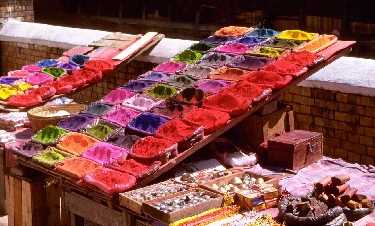
Another overnight bus trip and we eventually made it to Kathmandu, capital of Nepal. Kathmandu remains a hippie town, but the hippies (like in the rest of the world) have gained a taste for the little luxuries of life. There are some first class restaurants and cafes in the main tourist spots. But overall it retains its small town charm and doesn’t overwhelm you like an Indian metropolis. The birthday party turned out to be a bit of a fizzer but at least we made it there, not that we were staying long, time enough to collect Yvette. Kathmandu would have to wait - mountains beckoned, and in this part of the world they are hard to resist. After a quick assessment of our party the Everest trek was ruled out as too strenuous which left Annapurna as the only alternative, and if you are going to do the Annapurna trek, the full circuit is the way to go. So after a couple of days for washing it was time for another bus trip, this time to the lakeside village of Pokhara, start and finish of the Annapurna Circuit trek.
After a day ‘sorting’ permits and fees we ready. You CAN walk the entire distance of the trek, and don’t let any shonky travel-agent/hotelier tell you otherwise. Unfortunately we found this out too late and ended up on another bus back to a smaller village and then a ride on the back of a truck to the end of the motorable road - Dumre. The trek is basically circular leading up the Marsyangdi river, crossing the mountain pass of Thorong La, and then down the otherside along the Kali Gandaki river, all the time circling the Annapurna mountains I-IV. In the middle of all this you can enter the chamber which is composed of the Mucchupucchare (Fish Tail Mountain) Base Camp and the Annapurna Base Camp.
We traveled comfortably, walking about 10km per day. We would stop in the hostels by about 4 o’clock each night, usually meeting up with the same people (who were either just in front of us, or just behind - depending on when they departed the day before). After a few days of expectation and consequent disappointment the scenery changed, we crossed the snow line and the trees disappeared.
March 19: Dumre - Bessisahar
What a truck ride.March 20: Bessisahar - Bahundanda
We are starting to see some familiar faces now. There is an American, Chad, traveling with three Danes who are setting a ferocious pace but we seem to meet them at the same lodge each night.March 21: Bahundanda - Camje
I think my two travelling companions worked up quite an appetite today. It was quite a climb out of Sange to Jalgatt, and then another climb. We are actually starting to gain some altitude, and do some exercise. There was a field of baby cannibis plants carpeting the river bank outside of Sange, Shannon rolled around in bliss for a minute.March 22: Camje - Bagarchaap
Climbed continuously into Tal in approximately 2 hours. We should have continued last night and stopped here, it is a pretty little village on a section of the Marsyangdi Kola that has wide, flat banks. The Budhist influence is now quite prevalent with prayer wheels and arches at all the village entrances. There are 3 more crossing of the kola before we arrive at Bagarchaap where 5 westerners were killed in a 1995 landslide. It is a very sad place, rubble and boulders still divide the village, and few people stop here. Especially locals for the area is still unstable. I could see it snowing on the peaks around the town during the night - a new experience for me.March 23: Bagarchaap - Chame
The snow and the sleet had made the trail very boggy. One local girl, fully laden with produce on her back, withdrew her shoeless foot from one patch of mud to sounds of screams and wailing, but only laughter from her friends. As we successfully negotiated this a man in the group lost his footing and slipped over on to his back. He looked as helpless as an upturned tortoise with the pack on. "What to do, Kathmandu."We are still passing people return down the trail (suffering from AMS), and the pass was closed yesterday. Doubts about whether will see it open are quickly crushed.
March 25: Chame - Pisang
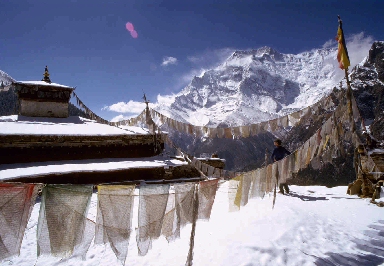
After a rest day in Chame which had some pleasant mod-cons it was back in the saddle. The countryside changed quite starkly from the pine forests to almost desert in appearance. Golden brown hills and rocky outcrops with the Annapurnas as a backdrop. Pisang has been divided by time into Upper and Lower due mainly to the tourist track being down near the river (Lower Pisang is just new lodges). As soon as we stopped here we indulged in the local bread and cheese and then went to explore Upper Pisang, which still had its charm. Then it really did snow, blanketing the brown hills in white.
March 26: Pisang - Manang
The trip out of Pisang was like a fairy-tale, pine trees and snow. Then we started the climb up to the old trail (its existence denied by a guide), and that was anything but a fairy-tale. When we finally stopped climbing at Gyaru it was time to rest, and take a chai. This was going to be a day of contrasts, we had refused to take the low trail, opting instead for the scenery, and at some point we would pass through Braga. A village that contained a bakery and had been advertised all along the trail for the last few days. The views didn’t disappoint and neither did the cakes. It turned out to be a baker from Kathmandu who had returned to setup a business in his home town.Apart from the small periods of rain at 3 o’clock each day, we had enjoyed some great weather; then we arrived in Manang.
Superman: Dean

Manang was a designated rest village, at 3000m and two days from the base of Thorong La (Thorong Phedi). It has a small hospital setup by the Himalayan Rescue Society and staffed by western doctors. They give regular talks on the perils of Altitude Sickness. This was the place to rest get acclimatised and prepare for the toughest part of the entire trek all condensed to one hellish day. This is where I met an American named Dean, and perhaps foolishly agreed to walk to the frozen Lake Tilicho with him. I would describe Dean as in his 40’s but still with his childish enthusiasm. He the genuine ‘been everywhere man’ and was now preparing to cross Thorong La for the 7th time as a warm up for the Everest trek. This time, however, he was a little under prepared and wore his Nepalise hiking boots (Bangkok sneakers) and carried no sleeping bag (only a local blanket which looked more like a small mattress). He entertained most with his anecdotes of diving with Whale Sharks off the South African coast to the story of the Blue Sheep skull he brought down from a walk in this area on a previous trip. So while Shannon and Yvette rested their blisters, I packed my few bread roles and a some hard-boiled eggs and headed off with Dean. It turned out we received some dodgy information about the trail from the locals and we headed up the left bank of the river bed only to be turned back several times. Finally we crossed the river and made our way up the other bank, only to realise we had run out of time - we would not make it to shelter that night, and now with the strong sun the chances of avalanche was high. We regretful retreated, this was not the first time Tilicho had got the better of Dean, but I felt it would not be his last attempt. As we walked back to Manang we passed two others out to attempt Tilicho, one them a Swede named Fred. Then two Germans in a village who had attempted and also failed citing waist deep snow as their ‘excuse’. I thought of Dean’s sneakers and felt instantly justified for our decision to return.
March 30: Stir Crazy in Manang
Still in Manang and the weather has turned for the worse. The frustrating thing is we are so close. There was two inches of snow last night and we are unable to move from the lodge. The Yak lodge must be making a fortune from it’s unwilling inmates. Some have moved on regardless of the poor visibility and the prospect of being caught in a worse place. The pass is most definitely closed now. One English girl has taken this badly, or at least that is how it appears, and went swimming in one of the lakes nearby.Martin, one of the Danes, came back yesterday from high up to get some medication for altitude sickness. He apparently is suffering a little from headaches.
March 31: Manang - Lattar
A little sunshine and the great escape. Saw quite a few yaks but not the fabled blue-sheep. I started experiencing a few headaches since Yakkattar, I must be pushing it too hard, so I have decided to sleep it off. But I wasn’t the only one, another guy who tried but apparently has headed back down to Manang.Thorong Phedi is only 1.5 hours away and Fred the Sweede has decided he can’t wait and has pushed on to reach it by nightfall., hoping to cross tomorrow. There is, however, no sign of Dean or the Danes.
April 1: Lattar - Phedi
April fools day, but I think that was the last thing on anyone’s mind. What was meant to be 1.5 hours turned out to be 3. I met an Australian Paul and his Canadian girlfriend Tina in the Lodge of Phedi. They walked from Manang today. Phedi is expensive, cold and there are dogs that bark all night so you can not rest. The toilets must be the worst encountered so far in India and Nepal: a few wooden floorboards, a 30cm x 60cm hole and a pile of excrement just centimeters below.The Hurricane Boys (the Danes and Chad) are here still, they have decided to rest a day here.
April 2: Phedi - Thorong La - Muktinath
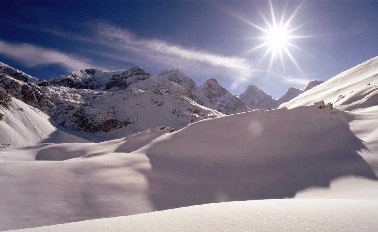
Our first mistake was that we started late, probably an hour late. I guess I was scared of the weather because it had snowed the night before and was snowing when we awoke. Our second mistake was that we weren’t prepared and had to wait on kitchen staff to make breakfast for the 60 people ready to cross and the only one that could speak English was not up yet. The third mistake was the lack of water anywhere and reliance on the hotel for supplying us.
The snow turned out to be just a low cloud. By the time we saw the sun and had decided it was time to go it was already too late for us. By the time we reached the first teahouse the weather had begun to turn, visibility dropped and the snow and wind was closing in. By the time I reached the top my head was pounding. The only way to tell that this was the top was the howls of relief from others in front of me.
The walk down, although it sounds easier, had a few degrees of added difficulty. Firstly freeze your toe, next add a snow storm to limit your visibility to almost zero and then have no idea where to go. Consequently we got lost 100m from the top. After wandering "almost" aimlessly for half an hour in knee high snow we simultaneously came face to face with two guys on skis coming from the opposite direction and a porter was seen off to one side hurrying along the correct path. We were saved! It was another four hours of sliding slipping and falling through mud, snow, and sludge. Then we dropped below the cloud line and Muktinath was is view.
April 3: Leor Part 1
We stayed in Muktinath a day, what with heat and some edible food, the place endeared itself to us. Muktinath is a pilgrimage site for both the Hindus and the Buddhists so we did the temple thing. Also staying in our lodge was an Israeli named Leor. He had previously become infamous through his antic on the pass. The guy sat down at the first teahouse on the pass and argued with his porter at the top of his voice, almost blocking the trail. Needless to say his porter was about to leave him fend for himself and it was his porter that we had seen leadin g everyone off the pass. Now they had brought their argument to the lodge. Another Israeli appologised to us in private and escaped early the next to avoid having Leor accompany him. Leor, cheese strands entangling his beard from the home made pizza, tried to explain his predicament, he wanted to join our group - HORROR. So out of the kindness of my heart I quickly helped negotiate a porter on Leor behalf.April 4: Muktinath - Kagbeni
Perhaps a little off the main trail Kagbeni was still worth the effort, appearing as an oasis in the desolate golden hills. A small Tibetan village at the entrance to the valley leading to the restricted region of Mustang. This was also our first view of the Kali Gandaki river, which would be our companion for most of the journey back.April 5: Kagbeni Marpha
Passed through Jomsom today which is the capital of this region, and has an airstrip and a military barracks. This is a starting point for those treks who fly you into town and let you walk out. So there are more trekkers here than I have seen on any other part of the trail. Jomsom is also ‘famed’ for its Jimi Hendrix restaurant (with an authentic? Jimi signature on the wall). It snowed at lunch but we decided to push on to Marpha reguardless.Leor Part 2
The porter arranged for Leor in Muktinath has lost Leor, how I would rather not know. When we me the guide who decided to speed down the trail to try and find him. Next we meet Leor cursing the guide that has STOLEN his belongings. This is becoming a soap opera.April 6: Marpha - Lete
With its cobbled streets and overall clean appearance Marpha was in stark contrast to Jomsom. It is well know for its apple products (including brandy) yet has problems delivering these to the markets. The country side is heavilly wooded in the shadow of Dhalugiri. When we made it to Kalopani (a sprawling village that straddled the road, we almost done for the day. Although we tried we could not seem to leave the village; the trap was set. We had decided to go to the next village (according to the map) which was Lete, yet we could seem to come to the end of Kalopani and eventually surrendered and stayed. The trap was sprung. We wandered about and eventually came to the realisation that Lete and Kalopani collided in a meandering sprawl. We had our passes stamped a resigned to our fate. The Swiss couple at our lodge saw the error of their ways and abandoned us after waiting an hour for a cup of tea.Addition to the check-list for lodges: screaming kids and social parties in the kitchen. We now have the Dhal Baat record for arrival of 2hrs 33mins, which turned out to be not worth the wait. The social party carried on outside our rooms until the wee hours guaranteeing little sleep that night.
April 7 - Lete - Tatopani
In our haste to escape Lete, we made a pact to leave without breakfast and scooted downhill until we arrived at Ghasa. After a little breakfast the days walk began to what would become the Shangri La that was Tatopani (Hot Water). The Dhalugiri Lodge is owned by an ex-patriot French woman and to it she has brought a little of western comfort to Nepal. The food is first rate with many types of cakes, fresh orange juice a good coffee. The other plus is that 5 minutes walk from the Lodge are the hot springs to soak those aching bones.Fortunately/unfortunately I have caught up with the Hurricane Boys, who having rested here a day are preparing to tackle the Annapurna Base Camp (ABC) in the morning. I now have the decision of resting for a day or soldering on to visit the base camp. The mad Sweede Fred is also here planing to do the detour. What choice do really have, this is one of those opportunities that are too good to pass up. Now for just one soak in the springs.
Leor Part 3
There are quite a few Israelis here talking about somebody on the trail who they would rather disown. Unfortunately the man in question has had to stay at a different lodge, but we pass each other as I go to the springs. I gather from our conversation that he has a little crush on Shannon.April 8 - Tatopani - Gohrepani
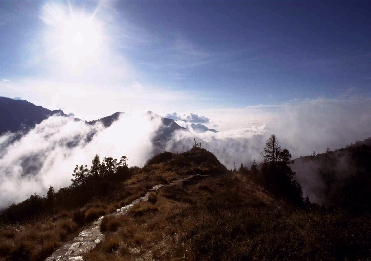
Fred had apparently been hit by ice from an avalanche when he tried to make it to Tilicho and had to be stitched up. His friend did manage to see the lake.
What comes down must go up. After that descent into Tatopani we now have the huge climb into Ghorepani. Bad start too, we took the low road to Beni, I guess we subconsciously didn’t want to climb. It was a slog, the Hurricane Boys travel hard, yet they rest more often too. After lunch we enter a Lali Gurans forest only to be greeted by rain and hail.
April 9 - Gohrepani - Chomrong
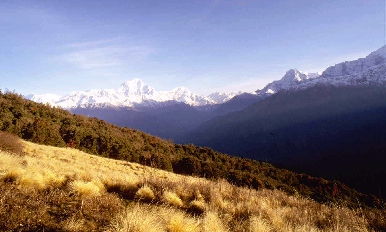
Gohrepani is noted for Poon Hill, a vantage point that gives a uninterrupted view of the Himalayan panorama, and although we had another long day ahead it was our first stop. So we climbed up Poon Hill only to climb the other side of the valley to get to Tadapani. If the going wasn’t so tough you could stop and admire this fairytale scenery: the moss, the mist and the flowering Lali Gurans. By the time we made it to Chomrong it had been another long, long, long day. The flying Dutchmen kicked some arse today, the ferocious pace was either attributed to the long day or Fred (being a Sweede).
April 10 - Chomrong - Himalaya
We can see the valley pass that enters into the base camp from here. Chomrong is on a hill so it will be another up and down day of walking, chased by rain. If I wasn’t saddle sore before I will be by the end of this.April 11 - Himalaya - MBC
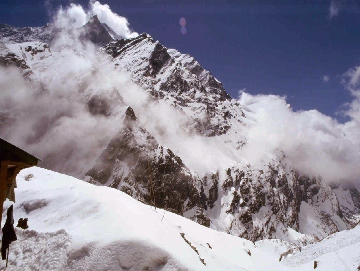
We were warned of the avalanche spurs, and we weren’t disappointed. They were tough to cross, and could someone tell those guys that if they are going to watch an avalanche come down on top of them to get off the track and allow the rest of us to get out of the way.
Muchhepuchhre, simply awesome, standing there with its black triangular face and a halo of clouds. Birds gliding effortlessly on the thermals and the mist rolling up the valley to engulf us. Tomorrow ABC.
April 12 - ABC

An early start to enable us to cruise along the frozen snow up to ABC. This must be the pinnacle of the trek. The walk between the base camps is up a vast chamber walled by huge mountains, Annapurna I and South at the western end Mucchepuchhre and Annapurna III in the east. This is a truly sacred site.
April 13 - MBC - Chomrong
We made an early start again to take advantage of the frozen snow. I am convinced Chomrong should be leveled. It is one huge hill that is must be climbed to pass through and the descent is no better. Everyone has the same feeling - it is time to get out of the mountains.April 13 - Chomrong - Dampus
The final hill into Deurali almost killed our resolve. We would have been heading for a bus if we could not have seen Dampus from up here. Dampus has some excellent views of the mountains, it was almost surreal to see them dancing in the clouds.April 14 - Dampus - Pokhara
This is the final day of walking and the body is protesting fiercely. By the time we made it into Sarankot it was time for a beer. There will be a few days of not walking now that I have finally stopped.
